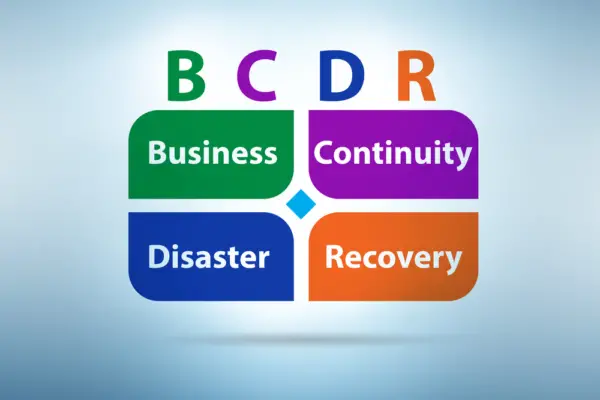Business continuity plans (BCPs) are essential for organizations to ensure that they can continue operating in the event of a disruption.
However, a BCP can quickly become outdated if it is not reviewed and updated regularly. The question then arises, how often should business continuity plans be updated?
The answer to this question is not straightforward, as it depends on various factors, such as the size of the organization, the complexity of its operations, and the frequency of changes in its environment.
However, industry experts recommend that BCPs should be reviewed and updated at least once a year, with additional updates made as needed. This ensures that the BCP remains relevant and effective in the face of changing circumstances.
Regular review and update of BCPs are crucial to ensure that they remain effective in mitigating risks and addressing potential disruptions.

In addition, organizations need to assess and incorporate technological advances, test and simulate their BCPs, adapt to new threats and changing environments, ensure compliance with standards and regulations, and provide communication and training for preparedness.
Key Takeaways
- Business continuity plans should be reviewed and updated at least once a year.
- Regular review and update of BCPs are crucial for ensuring their effectiveness.
- Organizations must assess and incorporate technological advances, test and simulate their BCPs, and adapt to new threats and changing environments to maintain the relevance of their BCPs.
Understanding Business Continuity Plans
Defining BCP and Its Importance
A Business Continuity Plan (BCP) is a comprehensive document that outlines how a business will continue its critical functions in the event of a disaster or crisis.
The purpose of a BCP is to minimize the impact of disruptions to business operations and ensure that the organization can recover quickly.
A BCP is essential for any business, regardless of its size or industry. Disruptions can occur at any time, and without a plan in place, the organization may struggle to recover.
A well-designed BCP can help mitigate risks, reduce downtime, and increase the likelihood of a successful recovery.
Key Components of a Business Continuity Plan
A BCP typically includes the following key components:
- Business Impact Analysis (BIA): A BIA identifies critical functions and processes that are essential for the business to continue operating. It also determines the impact of disruptions to these functions and processes.
- Risk Assessment: A risk assessment identifies potential threats and risks to the organization. This includes natural disasters, cyber-attacks, and other types of disruptions.
- Recovery Strategies: Recovery strategies outline the steps that the organization will take to recover critical functions and processes after a disruption. This may include relocating to a backup site, restoring data from backups, and implementing contingency plans.
- Crisis Management: Crisis management plans outline the steps that the organization will take to manage a crisis. This includes establishing a crisis management team, defining roles and responsibilities, and developing communication plans.
- Testing and Maintenance: Testing and maintenance are critical components of a BCP. Regular testing ensures that the plan is effective and up-to-date, while maintenance ensures that the plan remains relevant and accurate.
A BCP is a critical document that outlines how a business will continue its critical functions in the event of a disaster or crisis. It includes a Business Impact Analysis, Risk Assessment, Recovery Strategies, Crisis Management, and Testing and Maintenance.
By having a well-designed BCP in place, businesses can minimize the impact of disruptions and increase the likelihood of a successful recovery.
The Role of Management and Teams in BCP
Business Continuity Plans (BCP) are critical for companies to ensure they can continue to operate in the event of a disaster or disruption.
Updating these plans regularly is essential to ensure that they remain effective and relevant. In this section, we will discuss the role of management and teams in BCP.
Leadership Responsibilities
Management plays a vital role in ensuring that BCPs are updated regularly. They must ensure that the BCP team is in place and that it has the necessary resources to maintain and update the plan. Management must also ensure that the team is trained and has the necessary skills to update the plan effectively.
Leadership should also ensure that the BCP is aligned with the company’s overall strategy and objectives. This will help to ensure that the plan is relevant and effective.
Management should also ensure that the BCP is communicated to all stakeholders, including employees, customers, and suppliers.
Building an Effective BCP Team
Building an effective BCP team is essential to ensure that the plan is updated regularly. The team should consist of individuals with different skills and expertise, including IT, operations, and risk management. It is also essential to have a team leader who can coordinate the team’s efforts effectively.
The team should be trained regularly to ensure that they have the necessary skills to update the plan effectively. They should also be provided with the necessary resources to ensure that they can complete the updates promptly.
In conclusion, management and teams play a crucial role in maintaining and updating BCPs. They must ensure that the plan is aligned with the company’s strategy and objectives and that it is communicated to all stakeholders.
Building an effective BCP team is also essential to ensure that the plan is updated regularly and remains effective.

Regular Review and Update Schedule
Business continuity plans are critical to the success of any organization. They ensure that the organization is prepared to deal with unexpected events that could disrupt its operations.
However, a BC plan that is not updated regularly is of little use in the face of new and emerging threats. Therefore, organizations need to review and update their BC plans regularly.
Determining the Review Frequency
The frequency of BC plan review depends on several factors, including the size of the organization, its industry, and the complexity of its operations.
For example, a small organization with a simple structure may only need to review its BC plan annually, while a large organization with multiple locations and complex operations may need to review its plan more frequently.
Annual Review and Material Changes
Most organizations should conduct an annual review of their BC plan to ensure that it remains up-to-date and relevant. During this review, the organization should evaluate its plan against any changes in its operations, industry regulations, or the threat landscape.
In addition to the annual review, organizations should also update their BC plan in the event of any material change to their operations, structure, business, or location. For example, if an organization moves to multi-cloud storage, a BC plan built with the previous legacy storage in mind won’t be any good.
Updating the BC plan should be a collaborative effort that involves all relevant stakeholders, including IT, human resources, and finance.
The updated plan should be communicated to all employees and stakeholders, and regular training and testing should be conducted to ensure that everyone is familiar with the plan and knows what to do in the event of an emergency.
In summary, regular review and update of a business continuity plan is critical to ensure that an organization is prepared to deal with unexpected events.
The frequency of review depends on several factors, including the size of the organization, its industry, and the complexity of its operations.
An annual review is recommended, and the plan should be updated in the event of any material change to the organization’s operations, structure, business, or location.
Assessing and Incorporating Technological Advances
In today’s rapidly changing technological landscape, businesses need to stay up-to-date with the latest advancements in IT and AI solutions to ensure their business continuity plan remains effective.
We will explore two key areas that businesses should focus on to assess and incorporate technological advances into their continuity plan: evaluating new IT and AI solutions and keeping up with cybersecurity trends.
Evaluating New IT and AI Solutions
As technology continues to evolve, businesses need to be aware of new IT and AI solutions that can improve their continuity plan.
For example, cloud-based solutions can provide greater flexibility and scalability, while AI-powered automation can streamline processes and reduce the risk of human error.
When evaluating new solutions, businesses should consider factors such as cost, ease of implementation, and compatibility with existing systems.
Keeping Up with Cybersecurity Trends
As businesses become more reliant on technology, they also become more vulnerable to cyber threats. To ensure the continuity plan remains effective, businesses need to stay up-to-date with the latest cybersecurity trends and implement appropriate measures to protect their systems and data.
This includes regular vulnerability assessments, employee training on cybersecurity best practices, and the use of advanced security technologies such as firewalls and intrusion detection systems.
By regularly assessing and incorporating technological advances into their continuity plan, businesses can ensure they are prepared to handle any disruptions that may arise.
It is important to note that while technology can provide many benefits, it is not a substitute for a comprehensive and regularly updated continuity plan that also takes into account other factors such as human resources and physical infrastructure.
Testing and Simulation of Business Continuity Plans
Business continuity plans (BCPs) need to be reviewed and tested regularly to ensure that they are up-to-date and effective. Testing and simulation are essential components of BCPs, as they help identify gaps and areas for improvement.
Plan Testing Procedures
There are several testing procedures that businesses can use to assess the effectiveness of their BCPs. These include emergency drills, tabletop reviews, and simulations.
Emergency drills involve testing the response of employees to an emergency situation. This can include evacuating a building, responding to a cyber-attack, or dealing with a natural disaster.
The purpose of these drills is to identify areas where employees may need more training or support.
Tabletop reviews involve a group of stakeholders discussing hypothetical scenarios and identifying how they would respond. This can be an effective way to identify gaps in the BCP and ensure that all stakeholders are on the same page.
Simulations involve testing the BCP in a realistic scenario. This can include simulating a power outage, a cyber-attack, or a natural disaster. The purpose of these simulations is to identify areas where the BCP may not be effective and to make improvements.
Learning from Simulations and Drills
Testing and simulations are not just about identifying weaknesses in the BCP. They are also an opportunity to learn from mistakes and improve the plan.
After a simulation or drill, it is important to debrief and identify areas for improvement. This can include updating the BCP, providing additional training to employees, or making changes to procedures.
In conclusion, testing and simulation are essential components of BCPs. They help identify areas of weakness and provide an opportunity for improvement.
By regularly testing and simulating the BCP, businesses can ensure that they are prepared for any emergency situation.
Adapting to New Threats and Changing Environments
Business continuity plans are critical to ensure that organizations can continue to operate during a crisis or disaster. However, the threat landscape is constantly evolving, and it is essential to update the plans regularly to remain effective.
We will explore how often businesses should update their continuity plans to adapt to new threats and changing environments.
Monitoring Emerging Risks
It is crucial to monitor emerging risks to ensure that business continuity plans remain relevant. This includes staying up-to-date with the latest threats and vulnerabilities that may impact the organization.
For instance, the COVID-19 pandemic has highlighted the importance of having an up-to-date business continuity plan to help organizations better prepare for a crisis, manage the workforce amid the changing landscape, and support the resumption of regular business activities after the crisis has subsided [1].
Organizations should also consider the impact of natural disasters, cyber-attacks, and other incidents that may disrupt operations.
By monitoring emerging risks, businesses can identify potential threats and take proactive steps to mitigate them. It is recommended that businesses review their continuity plans at least once a year to ensure that they remain relevant and effective.
Updating Plans Post-Incidents
In addition to monitoring emerging risks, businesses should also update their continuity plans after an incident has occurred. This includes conducting a post-incident review to identify areas where the plan was effective and areas that need improvement.
By conducting a post-incident review, businesses can identify gaps in their plans and take corrective action to prevent similar incidents from occurring in the future.
For instance, the COVID-19 pandemic has highlighted the need for businesses to have a plan in place to manage remote work and maintain business continuity.
Businesses that did not have a plan in place were forced to adapt quickly, resulting in disruptions to operations and increased risk [2].
Businesses should update their continuity plans regularly to adapt to new threats and changing environments. By monitoring emerging risks and updating plans post-incidents, businesses can ensure that their plans remain effective and relevant.
Ensuring Compliance with Standards and Regulations
Business continuity plans are essential for organizations to ensure that they can continue to operate in the event of disruptions. However, it is not enough to simply have a plan in place.
Organizations must also ensure that their plans are up-to-date and in compliance with industry standards and regulatory requirements.

Adhering to Industry Standards
There are several industry standards that organizations can follow to ensure that their business continuity plans are appropriate and effective.
For example, the National Institute of Standards and Technology (NIST) provides a framework for improving critical infrastructure cybersecurity. The framework includes guidelines for developing, implementing, and maintaining a business continuity plan.
In addition to NIST, there are other industry standards that organizations can follow, such as ISO 22301, which provides a framework for a business continuity management system.
By adhering to industry standards, organizations can ensure that their business continuity plans are appropriate for their business and are effective in the event of a disruption.
Regulatory Requirements and Best Practices
Regulatory requirements and best practices also play a role in ensuring that business continuity plans are up-to-date and in compliance. For example, FINRA Rule 4370 requires firms to create and maintain written business continuity plans relating to an emergency or significant business disruption.
The rule spells out the required procedures, and the plan must be appropriate to the scale and scope of the firm’s business.
Other regulatory requirements may apply depending on the industry and jurisdiction. For example, organizations in the healthcare and financial services sectors may have specific compliance requirements related to business continuity planning.
Organizations must ensure that they are aware of these requirements and that their plans are in compliance.
In summary, organizations must ensure that their business continuity plans are up-to-date and in compliance with appropriate standards and regulatory requirements.
By doing so, organizations can be confident that their plans are effective and will allow them to continue to operate in the event of disruptions.
Communication and Training for Preparedness
Business continuity plans are only as effective as the people responsible for implementing them. Therefore, it is essential to ensure that employees are well informed, trained, and aware of the plan’s details.
Effective communication strategies and training programs can help achieve this goal.
Effective Communication Strategies
Communication is a crucial element of any business continuity plan. It is essential to establish clear lines of communication among employees, management, and stakeholders. Communication should be timely, accurate, and consistent.
One effective communication strategy is to establish a crisis communication team responsible for communicating with employees, customers, suppliers, and other stakeholders.
The team should be trained and equipped to handle different types of communication channels, such as email, phone, and social media.
Another strategy is to use a notification system that can quickly alert employees and stakeholders of any critical updates or changes to the plan.
This system can be integrated with other communication channels, such as email and text messaging, to ensure that everyone receives the message.

Training Programs and Awareness
Training programs and awareness campaigns can help employees understand the importance of business continuity planning and their role in implementing the plan.
These programs should cover the plan’s details, such as emergency procedures, communication protocols, and critical contact information.
Employees should also be trained in specific skills, such as first aid, fire safety, and disaster response. This training can help employees respond appropriately during an emergency and minimize the risk of injury or damage.
Awareness campaigns can be used to keep employees informed and engaged in the planning process. These campaigns can include posters, newsletters, and other communication materials that highlight the importance of preparedness and provide updates on the plan’s progress.
In conclusion, effective communication strategies and training programs are essential for ensuring that business continuity plans are successfully implemented. By keeping employees informed, trained, and aware, businesses can minimize the impact of an emergency and quickly return to normal operations.

Chris Ekai is a Risk Management expert with over 10 years of experience in the field. He has a Master’s(MSc) degree in Risk Management from University of Portsmouth and is a CPA and Finance professional. He currently works as a Content Manager at Risk Publishing, writing about Enterprise Risk Management, Business Continuity Management and Project Management.

